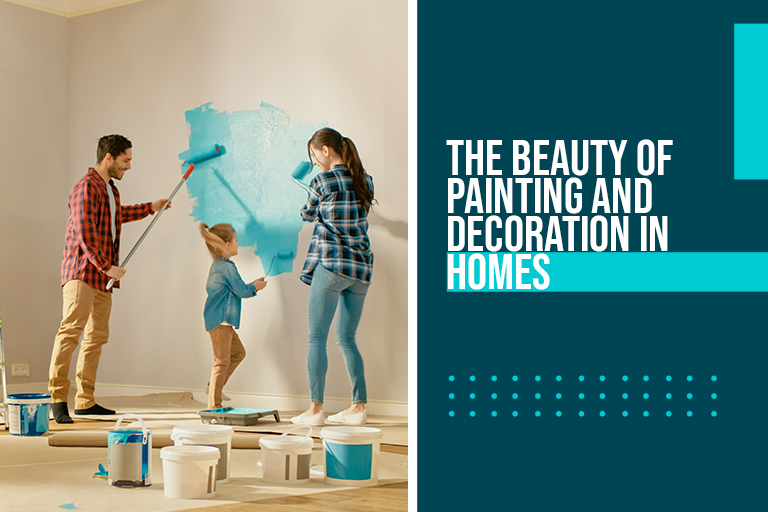
Painters and Decorators in London Select Paint Colour for Every Room
When designing your home, selecting the right paint colour for walls and hiring painters and decorators in London are essential. It can make a small room appear more prominent and a large room feels more intimate. It can lighten a dark room and prevent glare in a sunny space. It also warms a chilly north-facing room or brings life to evening light.
Struggling with a paint chart and your preferences? These are a crucial part of the equation. So, how will you go with the selection? How can you tell which colour should be your preference? How will the room orientation affect the paint that looks like when it is there on the wall?
Here is when a little colour theory can go a long way by letting you know how the colour behaves in different conditions found in a home. Here, our painters and decorators in London will help you choose the right paint colour to decorate your home correctly.
Know the colour terms:
Here, we describe the meaning of different colour terms.
- Colour – The appearance of a surface and how it reflects light.
- Hue – This is a synonym for colour.
- Shade – This is a dark version of a colour made with the addition of black shade. For example, it changes to dark blue.
- Tint - It is a light version of a colour made by adding white. For example, pink is a tint of red.
- Tone – This is a darker or lighter version of a colour.
- Colour wheel – Primary colours include red, blue, and yellow and secondary colours combine the primaries. This means red + yellow = orange; yellow + blue = green; red + blue = purple. The tertiary colours are red-orange, yellow-orange, yellow-green, blue-green, red-purple, and blue-purple.
- Warm colours – Some warm colours are reds, yellows and oranges. Think about the sun, fires and sunsets.
- Cool colours – These are blues, greens and blue-purples. Think of water and sky.
- Neutral colours – Colours that are not warm or cool but can be applied to colours not present on the wheel, like whites, greys, browns, and blacks.

Choosing the right paint colour
Are you starting from scratch? If yes, then you should choose any colour which will match to paint the walls. So, what do you need to take into consideration? You may ask yourself the following questions:
Which way does your room face?
It is essential as the quality of light differs based on whether the rooms look east, west, north or south. This can change the painted wall's appearance after it is on the wall.
The rooms facing towards the north will obtain cool and harsh light. So,
- Avoid cool colours as they will make the rooms more relaxed and look flat
- Select pinks or yellows if you want a hit of colour
- If you like a neutral scheme, then choose paints with pink or yellow undertones for a warm environment
- Go dark with deep red purples or on-trend charcoals
The rooms facing the east are brighter but more relaxed as the day progresses. So,
- Colours like green, pale neutrals or blue having greener or bluish base will keep a balance on sunshine, making it less intense.
- Select an intense shade that will come to life in the sun for a great morning.
South-facing rooms get warm and colour-flattering light throughout the day, and so,
- Paints appear yellower than on a paint chart, and you need to choose cool colours to keep a breezy atmosphere.
- Select neutrals with a more relaxed base by remembering that the room's light will warm them.
West-facing rooms will be more relaxed in the mornings and benefit from warm light later. So,
- Follow the same rules for east-facing ones, knowing that the sunlight should be balanced with cool colours or intensified with an intense colour by the end of the day.
Do you want to make the room lighter?
This might seem yes, but you can go darker instead of brightening the space by creating a cocoon effect in the bedroom.
Do you stay in the room during the day or evening?
The rooms generally occupied after dark are how the colour will look in artificial light rather than daylight.
Halogen bulbs show off paint colours, making colours appear warmer than daylight.
LEDs create cold light, though the latest versions are available in different colour temperatures. So, the higher the colour temperature is, the cooler and bluer the light will be, and the colder paint colours will appear. Generally, warm white LEDs better complement the paint colours.
Select the best paint colour for a small or dark room
If the room is small, paint colour may bring a transformative effect, making it look larger. On the other hand, cool colours appear further away, so you need to stick to these shades rather than warm hues.
In the case of small or dark rooms, pale neutrals and whites reflect the most light. Hence, the overall impression will be airier, allowing the room to look bigger.
Does your room look darker as it faces towards the north? Well, you need to follow the guidelines of colour and select pale hues with a yellow or pink base to prevent a chilly atmosphere at home.
Choose the same paint colour on all four walls in a small room. You must make contrasts to know more about the beginnings and endings of different areas.
Which paint colour to select for which room
After you have chosen colours to expand the room's proportions visually or considered its orientation, you'll mainly be using them. It is the right time to select the paint colour that complements the space's function.
Which paint colour will work the best in a living space?
If you want living room walls to be the background for stronger shades in accessories, furniture and rugs, then white, cream and variations of off-white are great options.
Grey neutrals are still in demand and are a practical choice for homes. These are easy to layer with other grey tones in the room or accent with a pop of vibrant shade.
In recent years, favourites in many houses have been blue shades, ranging from relaxing ocean teal tones to sophisticated darks.
Almost-blacks are an attraction for the living rooms and are a good choice for giving big spaces a more intimate feel.
Which paint colour to select for the kitchen
White-painted walls can be your true partner for keeping the overall look clean. Introduce wood with flooring or a dining table and chairs for warming contrast.
White or off-white walls can be an attractive setting for everything from deep blue to grey and black units, making the cabinetry noticeable.
Choosing cream or white units makes the presence felt against a deep blue wall.
The kitchen is a sociable space, and selecting warm paint colours is a natural choice. Make sure you stick to a feature wall that has neutral paint.
Freshen up with mid-toned greens or blues, as they are an excellent choice for the style schemes.
Which paint colour is the best for a bedroom?
You can make the bedroom warm and comfortable by selecting moody shades like greys and indigo blue. Try to maintain a balance between darker walls and pale floors.
Ensure you follow the botanicals trend with foliage green walls and accessorise them with house plants.
Keep the look calm by selecting pale neutrals, mainly when the objective is to make a small bedroom look spacious. This is among the best bedroom paint colours.
Grey shades are still in great demand and are contemporary and sophisticated.
When looking for paint ideas for your kid's bedroom, hues like denim blue and yellow or painting murals or stripes will be a treat. They are easy to update with different paint colours when they change in taste.
What are the paint colours for the bathroom?
You must keep the look clean and spacious in a bathroom by selecting white walls. This can be utterly fuss-free with coloured tiles, though it will work with white tiles, too, as different surfaces can create more decoration.
Choose a watery theme with an ocean-inspired green or blue shade.
Complement a traditional-style bathroom by selecting a soft, neutral pale grey or cream that looks very elegant.
Select bold colours in the bathroom, like fizzy orange, sunshine yellow or acid green.
How to select the right white paint
There is a broader choice of white paint which can create different effects. Selecting space-expanding off-whites is the perfect choice for the contemporary finish in rooms that do not look northward. They can also suit the warm light of south-facing rooms, whatever the decor style.
You may opt for true or pure whites to get maximum reflection of natural light coming into the room. Search for names, including words like clean pure, to check the description of your chosen decorating company in London.
Some whites are excellent with a green, blue, violet or grey base, so you would like to prevent chilling for a north-facing room with any of them. You can pick a version with a yellow or pink undertone.
What you should know about neural paint colours
Walls painted in a neutral make a versatile setting for a room scheme. Greys, whites, browns and blacks have different tones, so the word neutral may conjure up an image of a very pale wall. The colour can make much of a statement in the form of non-neutral.
Neutrals may be complemented with other neutrals from the same family in accessories, furniture, and soft furnishings for a tranquil look. They may be the stage on which colour from other room parts is shown to the best advantage.
Unlike neutrals and whites, which have different bases, you need to consider the room's orientation to get an overall effect.
Living space should have a warm and heather-coloured base, which make it a good choice for rooms with incredible light.
Choose paint colours for the exterior of your home
Want to change the exterior of your home? The exterior paint colours can be seen in the daylight, so select interior paint colours you like to reproduce the appearance.
Are you selecting a paint colour for your home? You should opt for the appropriate colour on the exterior. Many paint companies have paints which reproduce period shades, making it easy to choose. Complementing the surrounding houses by adopting the same practice is a good idea.
If you are staying in a listed building or conservative area, you may need consent to change the external appearance of your home. Get in touch with our decorators in London, who can help you select paint colours for every room of your house.





